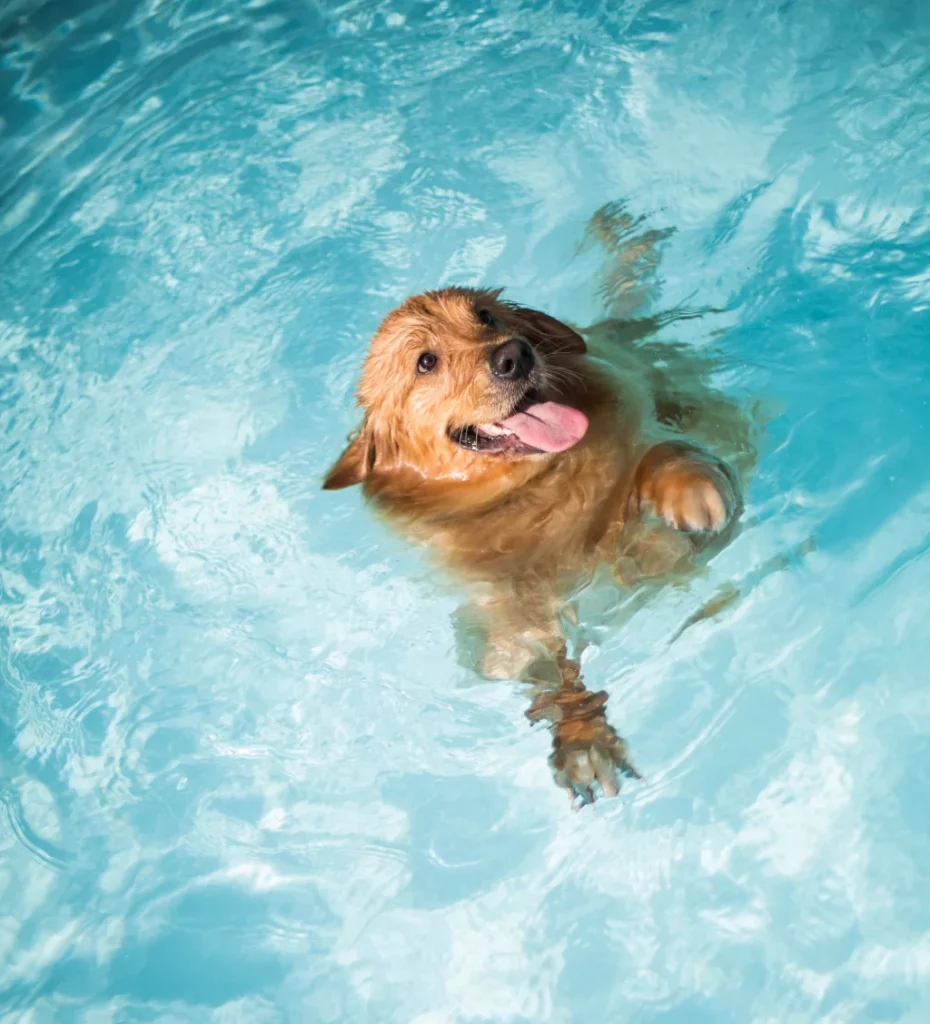Note: We may earn a commission from helpful, relevant links in our content. No cost to you. See our privacy policy.
Ever find your pooch sniffing around curiously in the park, making a beeline for the nearest water source? This probably has you asking, just how well can dogs smell water?
Isn’t that simply astounding? This super-sniffing ability forms an integral part of their survival instincts, lending credence to their reputation as man’s best friend. Let’s explore this intriguing topic together.

Can My Dog Really Smell Water?
Yes, your dog can absolutely smell water! Dogs possess up to 300 million olfactory receptors in their noses, compared to our mere 6 million. This incredible sensory equipment enables them to pick up on the scent of water molecules in the air, particularly in outdoor environments.
Moreover, it’s fascinating to note that dogs not only possess a greater number of olfactory receptors but also a larger part of their brain is dedicated to analyzing smells. This is why a dog’s sense of smell is estimated to be between 10,000 to 100,000 times more acute than ours.
In fact, as Alexandra Horowitz, a dog cognition researcher at Barnard College puts it, while we might notice if our coffee has had a teaspoon of sugar added to it, a dog could detect a teaspoon of sugar in a million gallons of water – that’s nearly two Olympic-sized pools!
So, if your pup is enthusiastically sniffing around or seems drawn to a particular direction during your walks, they might just be catching the scent of a nearby water source.
Let’s take a moment to understand the stark difference between our olfactory abilities and that of our canine companions. This table provides a comparison of the sheer power of a dog’s sense of smell compared to humans:
| Species | Olfactory Receptors | Area of Brain Dedicated to Analyzing Smells | Detection Range |
|---|---|---|---|
| Dogs | Up to 300 million | 40 times greater than humans | Up to 3 miles |
| Humans | 6 million | Relatively small | Limited |
As you can see, dogs outshine us by leaps and bounds when it comes to their sense of smell, which certainly assists them in detecting water sources.
Now, while all dogs have an impressive sense of smell, some breeds stand out even among their peers. These breeds are particularly known for their water-detecting capabilities:
- Labrador Retriever
- Bloodhound
- German Shepherd
- Newfoundland
- Coonhound
These breeds, traditionally used in roles that require an acute sense of smell, are renowned for their superior olfactory capabilities. Don’t be surprised if your pet from one of these breeds often leads you to water bodies during your walks.
How Far Can Dogs Detect Water?
While exact distances can vary depending on factors such as breed, environment, and individual dog’s health, dogs have been known to detect water from as far as three miles away!
Their sniffing prowess doesn’t stop at still water sources either. Dogs can also pick up on the scent of moving water, such as streams and rivers, thanks to the distinct olfactory cues provided by wet earth and vegetation.
To provide a bit more insight into dogs’ extraordinary smelling abilities, consider this: a dog’s sense of smell is so powerful that they can even distinguish the smell of rain. Dogs are sensitive to atmospheric pressure changes and can smell the rain even before it arrives. Their noses can detect the slightest change in humidity and temperature that occurs as the rain approaches.
So, the next time you see your dog acting unusually and there’s not a cloud in the sky, don’t be surprised if you soon find yourself needing an umbrella!

How Do Dogs Find Water?
Dogs are indeed extraordinary when it comes to detecting water, and this isn’t limited to simply smelling or hearing it.
What sets them apart is the sheer acuity and precision of these senses, as well as the ability to integrate sensory information in a way that most other animals can’t.
For instance, their olfactory capabilities are finely attuned to detect minute changes in humidity levels that often precede the presence of a water body. They can literally sniff out moisture in the air, a capability that’s so precise, it allows them to track the direction of water flow based on the concentration of scent particles.
Similarly, their auditory skills aren’t just about hearing the sound of water. They can discriminate between different types of water sounds, distinguishing the gush of a river from the drip-drip of a leaky faucet. In fact, some breeds can even pinpoint the direction of water solely from the sound it makes.
Lastly, dogs don’t just remember landscapes – they read them. They comprehend that water tends to be found in lower-lying areas, yes, but they can also detect subtle cues such as greener vegetation or the presence of specific water-loving plant species.
They integrate these pieces of information to create an almost map-like understanding of where water might be found, guiding their explorations accordingly.
Can Dogs Recognize Water in a Bottle?
It may seem surprising, but dogs can indeed recognize water in a bottle! This recognition doesn’t come from the same olfactory process used to locate a natural water source. Instead, it’s largely a result of associative learning.
When you frequently offer your dog water from a bottle, especially during walks or trips, they associate the object (the bottle) with the reward (the water). Over time, they understand that a bottle often contains water. This is similar to how they know that food comes from their bowls.
However, it’s important to note that the smell of the plastic bottle itself is not likely to make your dog thirsty. They learn the water-bottle association mostly from repeated experience.
Do Dogs Pick Up Scent Underwater?
You may be surprised to learn that dogs can actually detect scents underwater, a skill that comes from their remarkable aquatic adaptations.
My older German Shepherd, Sam, demonstrated this to me during one of our trips to the lake. He’d spot a stick or a toy that sank in shallow water, submerge his snout and swiftly retrieve it!
This behavior is actually due to the fact that dogs exhale through the sides of their noses while keeping the central airway closed to sniff – a mechanism that allows them to follow a scent trail even underwater.
Speaking of remarkable aquatic adaptations, Sam’s younger sibling, Charlie, a Labrador Retriever, once amazed me with an even more astonishing demonstration of a dog’s ability to pick up scent underwater. Labs are known for their love of water, but Charlie took it to another level.
We were at the beach, and he was happily swimming when he abruptly dove under. To my astonishment, he resurfaced with an old tennis ball in his mouth! That ball had been underwater for who knows how long, yet Charlie was able to detect its scent while swimming and dive down to retrieve it.

Do you love water adventures with your dog? Then why not boost your pup’s water-detecting skills with the ‘KONG Aqua Floating Fetch Toy‘. Not only is it a great way to exercise your pet, but it can also help train their super sniffing ability!
This keen underwater sniffing ability isn’t unique to Sam and Charlie. In fact, it’s an adaptation seen in many water-loving breeds. Dogs have been known to locate sunken objects in over 40 feet of water, showing just how powerful their noses truly are.
I hope you’ve found these insights into our canine friends’ water-detecting capabilities as fascinating as I do. Understanding their extraordinary senses not only helps us appreciate them more but also enables us to engage with them in ways that cater to their natural instincts and abilities.
After all, every splash in the lake, every sniff at a fountain, is a testament to their remarkable evolution. We can only speculate about how will dogs evolve further. Here’s to many more wet and wild adventures with our furry friends!
FAQs
Does breed impact a dog’s ability to smell water?
While all dogs have an acute sense of smell, some breeds have more developed olfactory senses than others. For instance, breeds traditionally used for tracking, like Bloodhounds or Basset Hounds, might detect water from a greater distance compared to others.
Can dogs distinguish between different types of water?
Dogs can distinguish between various types of water based on the different scent profiles. For example, saltwater has a significantly different scent to freshwater due to its mineral content, and stagnant water smells different from flowing water due to the presence of bacteria and algae.
Do dogs use their sense of smell when swimming?
Even while swimming, dogs continue to use their sense of smell. They exhale through the sides of their nostrils and keep the central airway closed, allowing them to take in new scents even in aquatic environments.
Can a dog’s water-smelling ability decline with age?
Just like humans, a dog’s sensory abilities can decrease with age. This includes their ability to smell water. However, this decline is usually gradual, and regular mental and olfactory stimulation can help maintain their scent-detection capabilities.
Alex, a passionate animal lover, has experience in training and understanding animal behavior. As a proud pet parent to two dogs and three cats, he founded AnimalReport.net to share insights from animal experts and expand his knowledge of the animal kingdom.










Your writing style is captivating! I was hooked from the first paragraph. The way you weave facts with narrative is truly skillful. This post not only informed me but also entertained. Can’t wait to see what you write next!